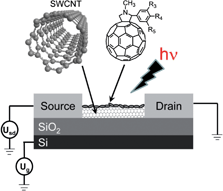A team of researchers led by Takashi Nakanishi from the National Institute for Materials Science in Japan have made a nanocarbon hybrid of a C60 derivative and single-walled carbon nanotube (SWCNT) to be used in photovoltaic devices. The high performance of the nanomaterial is the result of a combination of the optical and electronic properties of the SWCNTs with the electron-accepting property of C60.

Photoconductivity experiment using a field-effect transistor equipped with the carbon nanohybrid
The C60 is decorated with long alkyl chains which have an affinity for the SWCNT surface, avoiding the problems associated with covalent functionalisation when combining such materials. By incorporating C60 into the hybrid, the SWCNTs were soluble in organic solvents meaning classic wet processes can be used to fabricate the photovoltaic device.
The nanocarbon material also has the added benefit of being superhydrophobic, providing the device with waterproof properties.
To find out more about this research, read the Chemical Science Edge article.










